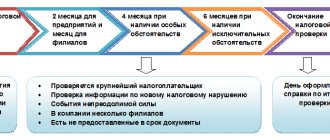General information
An on-site inspection agreement is formed on the basis of Art. No100 Tax Code of Russia. Issued within 2 calendar months from the date the inspector draws up the inspection certificate. The form records the final results of the inspection. It describes in detail the violations identified during the analysis and methods for eliminating them. Please note that the on-site inspection document must be drawn up in several cases:
- After each on-site inspection.
- Within ten days after a desk audit during which violations of the law were identified.
- After each on-site procedure regarding KGN.
No more than three months are allotted for drawing up the act after drawing up a certificate of inspection results. The form of the on-site inspection report has been approved by the Federal Tax Service of Russia. Detailed information about the structure and content of the form is described in Appendix No.24. The act was adopted back in 2015 and has not been amended since then. According to the law, the sheet of the on-site inspection report is certified by the specialists who conducted the inspection of the business entity and by the taxpayer himself. Please note: in cases where the person being inspected or his attorney refuses to sign the document, a note about this is made on the form.
Special requirements for describing facts of violation of the law
The possibility of bringing the taxpayer to justice depends on the quality of the description of the circumstances of the violation of the law identified by the audit, therefore the Federal Tax Service of the Russian Federation explains in detail the procedure for filling out the descriptive part of the act.
IMPORTANT! By virtue of clause 2 of Art. 54.1 of the Tax Code of the Russian Federation, the tax authority needs to focus on collecting evidence confirming the existence of the purpose of non-payment of tax and the fulfillment of contractual obligations by third parties.
The description of each fact must contain (subparagraphs “a–d”, paragraph 3.2 of Appendix 24):
- circumstances and method of committing the violation;
- evidence (links to primary documents);
- links to information obtained during the inspection (interrogation protocols, examinations, inspections, etc.);
- financial analysis of discrepancies and calculations of arrears;
- qualification of the violation.
When drawing up the act, the data from the updated declarations are taken into account.
If possible, the description of offenses should be understandable to persons who do not have special education in the field of accounting and law.
How to compose correctly
The on-site audit report template is drawn up in two versions: one remains with the tax inspector, the second is given to the person being audited. In some cases, the inspector issues three copies of the forms. As a rule, this is done during a repeated or joint inspection.
Federal Tax Service employees are required to hand over the completed agreement to the taxpayer within five working days after the act has been signed. As a rule, the form is handed over personally to the person being checked or his representative. A sheet is issued for receipt, where the date of receipt of the paper by the organization is indicated. In cases where an entrepreneur or his legal representative avoids receiving the form, the inspector records this fact in the inspection report and sends it by registered mail. In such a situation, the following rules apply:
- The document is sent to the company address indicated in the Unified State Register of Legal Entities.
- The delivery date is delayed, i.e. The act is transferred not within 5 days, and not later than 6 days after sending the envelope.
Please note: the company has the right to appeal the decision of the tax inspector if it does not agree with it. In this case, it will be necessary to draw up written objections regarding the entire act and its individual provisions. You have 1 month to appeal from the date of receipt of the form. Afterwards, the taxpayer will no longer be able to do anything. Note that the person being checked can be given both the original document and its copy. In both cases, the contract is considered valid.
Checking act
No later than two months from the date of registration of the certificate, the inspectors draw up an on-site tax audit report (paragraph 1, clause 1, article 100 of the Tax Code of the Russian Federation). Its form was approved by order of the Federal Tax Service of Russia dated December 25, 2006 No. SAE-3-06/892. Inspectors must draw up an act, even if the results of the inspection did not reveal any violations (paragraph 1, paragraph 1, article 100 of the Tax Code of the Russian Federation, letter of the Federal Tax Service of Russia dated April 16, 2009 No. ШТ-22-2/299). In this case, the inspectors indicate in the report that there are no violations of tax legislation (subclause 12, clause 3, article 100 of the Tax Code of the Russian Federation).
Tax legislation establishes clear requirements for the execution of an on-site inspection report (clauses 3, 3.1, 4 of Article 100 of the Tax Code of the Russian Federation, Requirements approved by order of the Federal Tax Service of Russia dated December 25, 2006 No. SAE-3-06/892). For more information about what information inspectors must include in the inspection report, see the table.
If, when preparing an inspection report, the inspectorate has doubts about the interpretation of the legislation, the draft act can be sent for preliminary approval to the regional tax department. For example, this is possible if there are no official explanations from the Federal Tax Service of Russia on some issues or if these explanations do not coincide with the position of the Ministry of Finance of Russia. The deadlines for approval of draft inspection reports are set by the regional Federal Tax Service. However, these deadlines should not increase the total duration of preparation of the act (two months) established by paragraph 1 of paragraph 1 of Article 100 of the Tax Code of the Russian Federation. This follows from the provisions of Section II of the Procedure, approved by Order of the Federal Tax Service of Russia dated October 17, 2013 No. ММВ-7-3/449.
Situation: is it possible to cancel the inspection decision made based on the results of an on-site inspection? The inspection drew up an on-site inspection report containing violations (errors).
It is possible if violations committed during the preparation of the report led to the adoption of an incorrect decision based on the results of the on-site inspection.
The decision on a tax audit is subject to cancellation if the inspection violates the essential conditions of the procedure for considering audit materials. Thus, the inspection decision is canceled if the inspection does not provide the organization with the opportunity to participate in the consideration of the inspection materials and provide explanations on them. This is stated in paragraph 2 of paragraph 14 of Article 101 of the Tax Code of the Russian Federation. In addition, other violations related to the procedure for reviewing materials that could lead to the adoption of an incorrect decision (paragraph 3, paragraph 14, article 101 of the Tax Code of the Russian Federation) may become grounds for canceling the inspection decision.
The on-site audit report is one of the main materials of the tax audit, after consideration of which the inspectorate makes a final decision based on the results of the audit (clause 1 of Article 101 of the Tax Code of the Russian Federation). Consequently, violations committed by the inspectorate when drawing up the report may become the basis for making an incorrect decision based on the results of the on-site inspection. In this case, the inspection decision is subject to cancellation in full or in part related to the violation. In arbitration practice, there are court decisions that confirm the legitimacy of this conclusion. Thus, the inspection decision made based on the results of an on-site inspection can be canceled (in whole or in part) if the inspection made the following violations (errors) when drawing up the report:
- incorrectly applied the legislation and made incorrect conclusions, which were reflected in the final decision (see, for example, the decision of the Supreme Arbitration Court of the Russian Federation dated October 6, 2009 No. VAS-12395/09, resolution of the Federal Antimonopoly Service of the West Siberian District dated June 3, 2009 No. F04-3218/2009(7668-A46-26), F04-3218/2009(8926-A46-26), Moscow District dated September 29, 2009 No. KA-A40/6946-09);
- distorted the facts established during the audit (see, for example, resolution of the Federal Antimonopoly Service of the Ural District dated November 25, 2009 No. F09-9205/09-S2);
- assessed additional taxes, penalties and fines for periods that could not be covered by the on-site inspection (see, for example, the resolution of the Federal Antimonopoly Service of the Far Eastern District dated February 20, 2008 No. F03-A73/08-2/126);
- did not substantiate the fact of a tax offense and held the organization accountable for committing it (see, for example, the determination of the Supreme Arbitration Court of the Russian Federation dated June 4, 2009 No. VAS-6861/09, resolution of the Federal Antimonopoly Service of the East Siberian District dated February 10, 2009 No. A33- 6906/07-F02-15/09, Central District dated January 21, 2010 No. A35-1157/08-C15, dated November 30, 2009 No. A64-3933/07-16, Volga-Vyatka District dated December 21, 2009 No. A82-9362/2008, Volga District dated November 24, 2009 No. A72-2919/2009, West Siberian District dated September 9, 2009 No. F04-5332/2009(18985-A03-34), Moscow District dated April 6, 2009 No. KA-A40/2403-09, dated January 20, 2009 No. KA-A40/11945-08, Northwestern District dated May 4, 2009 No. A56-13415/2006, Ural District dated August 28, 2008 No. Ф09-6143/08-С3).
As a general rule, the on-site tax audit report is drawn up in two copies: one for the inspection, the second for the organization. When conducting a joint tax audit, the act is drawn up in three copies: the third copy is transferred by the inspectorate to the internal affairs bodies. When conducting a repeated on-site inspection in order to monitor the activities of a lower inspection, the report is also drawn up in triplicate. In this case, the higher tax authority that conducted the audit will send the third copy of the report to the inspectorate. This is stated in paragraph 9 of the Requirements approved by order of the Federal Tax Service of Russia dated December 25, 2006 No. SAE-3-06/892.
How to fill it out correctly
How to correctly draw up a sample on-site inspection report is described in detail in Article 100 of the Tax Code. The legislative act states that the form must consist of three sections:
- Introductory or general. The input information about the taxpayer is described in detail here.
- Basic or descriptive. This part lists the types of violations in detail.
- The final one is recommendatory. This includes the inspector's advice on how existing violations can be corrected. The section also contains instructions from the Federal Tax Service.
To correctly fill out an example of an on-site inspection report, you will need to indicate:
- name of the form, date of registration and serial number;
- names of all inspectors (you must write the full initials, position, division of the Federal Tax Service);
- name of the organization or initials of the taxpayer (indicate the data in full and abbreviated);
- the address where the company is located or the taxpayer lives;
- serial number and date of decision on field activities;
- list of official documents to be checked;
- the period for which the inspection is carried out;
- start and end times of the check;
- a list of tax levies subject to audit;
- information regarding the control programs used;
- a note about the absence of violations or facts confirming their presence;
- final marks and instructions on how to eliminate offenses, links in the presence of liability measures.
According to the law, verification papers must be drawn up within a strictly established time frame: within two months in ordinary cases, and three for the KGN. Please note that if the tax inspectors for some reason violated the deadlines, the results of the audit will not be cancelled. The taxpayer, in turn, can file an appeal in the usual manner. If the taxpayer does not agree with the conclusions made in the report, he has the right to draw up and file an objection. This can be done no later than 1 month from the date of receipt of the official paper.
What kind of document is this, legal regulation
As mentioned earlier, one of the responsibilities of the tax authority is an on-site inspection.
To do this, Federal Tax Service employees go directly to the location of the enterprise. For such control, a truly serious violation of the law is necessary - for example, if a company constantly submits zero reports and at the same time records a loss. Based on the results of the tax audit, a special act is issued, which will indicate the following data:
- errors that were found in accounting and tax accounting;
- requirements for their elimination.
This document contains the following subsections:
- name of the act and serial number;
- the date when it was compiled;
- in relation to whom the check was carried out;
- reasons for its implementation;
- list of documentation that was submitted for control;
- for what specific tax and during what period the audit was carried out;
- the total duration of the procedure;
- activities carried out during its course;
- what exactly the inspectors found (descriptive part);
- conclusions and results of the inspection, a list of identified violations;
- a list of persons who performed it;
- a place for the signature of the inspectors, as well as the responsible person who receives this act.
At the end of the document there must be a stamp with a transcript.
If we talk about legal regulation, then the check should be carried out in accordance with the following legislative norms:
- Article No. 83 of the Tax Code of the Russian Federation, which describes the procedure for maintaining records of legal entities.
- Article No. 89 of the Tax Code, which describes where and how an on-site audit should be carried out.
- Article 91, which states that the taxpayer is obliged to provide the tax authorities with free access to all papers and premises that are related to the procedure.
- Article 93, which states that the Federal Tax Service has the right to request data from counterparties.
- Article 100, which states exactly how the report should be filled out during and after the inspection.
Sample on-site inspection report
Let us remind you that an inspection report is drawn up even in cases where the commission did not identify any violations. The procedure for completing the form is described in detail in Article 100 of the Tax Code of the Russian Federation. Of course, in practice everything is completely different. We recommend downloading the on-site inspection report and studying in detail the structure of the official paper and the rules for its preparation.
Results
A report based on the results of an on-site tax audit is drawn up by the tax authorities who conducted the audit. It must be drawn up in the form approved by the Federal Tax Service of Russia in order No. ММВ-7-2/ [email protected] (Appendix 27), and contain a description of the violations identified and the decision made by the tax authorities.
Sources:
- Tax Code of the Russian Federation
- Order of the Federal Tax Service of Russia dated November 7, 2018 N ММВ-7-2/ [email protected]
You can find more complete information on the topic in ConsultantPlus. Free trial access to the system for 2 days.
Completed example of a tax audit report
Appendix 23 to the order on document forms contains the form of the tax audit report, which consists of introductory, descriptive and summary parts. The requirements for filling out the form are given in Appendix 24 to the order on document forms and are as follows:
- the act is drawn up in Russian only in the approved form; it can be drawn up either using software and printing, or by filling it out by hand;
- the act should not contain any corrections, blots or erasures, except in cases certified by the signatures of a representative of the tax authority and the person being inspected; the use of proofreaders and covering agents is also unacceptable;
- the act must reflect all the essential circumstances of the offense, if any, and contain its qualifications;
- the presentation of the circumstances must be made clearly, concisely, in an accessible form and systematically.
Papers obtained during the inspection should not be attached to the report, as they constitute a secret protected by law. All necessary applications are prepared in the form of statements.
You can fill out the report by following the link: Tax audit report.
Check completion procedure. Contents of the certificate of completion of the GNP
The procedure for completing an on-site tax audit includes drawing up a certificate, which is handed over to the taxpayer on the last day of the tax return. The date of preparation of the certificate is the date of completion of the inspection (clause 8 of Article 89 of the Tax Code of the Russian Federation).
The contents of the certificate of completion of the on-site tax audit are disclosed in Appendix 7 to Order No. ММВ-7-2/ [email protected] The certificate, along with the required details: date, number, data of the document (decision) on the appointment of the GNP, information about the taxpayer, must contain information:
- about the subject of the audit (taxes and period);
- all suspensions, resumptions, extensions;
- start and end dates of GNP.
The certificate is signed by the head of the audit team and the taxpayer and is immediately handed over to the person being audited. If a person evades receiving a document, the certificate is sent by registered mail (clause 6.2 of letter No. AS-4-2/13622) or via telecommunications channels.






